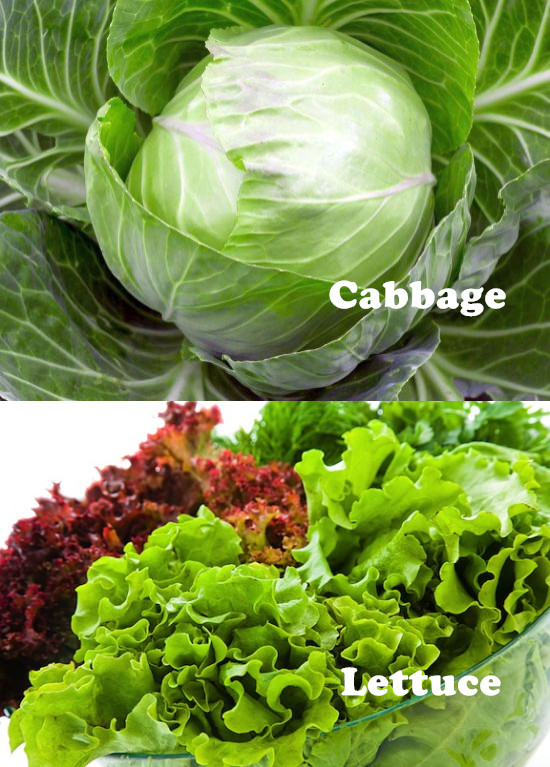Lettuce and cabbage are often confused with each other. Etymologically-speaking, the term "lettuce" comes from the Latin word meaning "milk". Cabbage is derived from the terms "Normanno-Picard caboche", which means head. While both are forms of vegetables, they are different from one another and have different nutrients amount.
Cabbage falls into the category of a cruciferous vegetable, such as broccoli and cauliflower. Lettuce, on the other hand, is a kind of leafy green vegetable related to spinach. Both are healthy diet choices and can be added to a healthy diet. The differences between the two can come from the way they are grown and the ways they are used in the diet.
Difference Between Cabbage and Lettuce
 While cabbage and lettuce can look similar to one another, they still have some differences on several aspects. Here are several of them.
While cabbage and lettuce can look similar to one another, they still have some differences on several aspects. Here are several of them.
1. Family (Plant Species)
Lettuce and cabbage come from different plant species. Lettuce involves a variety of related greens that come from the Lactusa family or Asteraceae family of vegetables. Cabbage, on the other hand, comes from the Brassica plant family.
Although cabbage and lettuce both involve green leaves that layer over other layers of leaves, cabbage is tougher and contains less water than lettuce. Cabbage is usually made into things like cole slaw or boiled cabbage meals, while lettuce is used often in salads.
2. Growing Conditions
Growing condition can be one difference between cabbage and lettuce. Ideal conditions for lettuce growth include sandy soil that has a pH value of between 6 and 7.Lettuce grows best in the shade where it can be protected from the heat daytime, especially in summer.Therefore, some growers cover the lettuce plants with a cloth-like mesh that keeps it away from the sun's heat rays. Lettuce leaves can dry out quite quickly so that moisture is often required for it to grow successfully.
Cabbage, on the other hand, grows best in cool temperatures. It can be adequately grown in many different soil types but it shouldn't be grown in soil that has a pH level of greater than 6.5. The roots of cabbage can dry out quickly; therefore, enough moisture is required for proper growth of cabbage.
3. Appearance
The difference between cabbage and lettuce can be seen in their appearance. Cabbage consists of a short stem and a head that forms a bulbous shape. Cabbage is usually green but there are other varieties like purple or red ones. The outer leaves are often too tough to eat, and the inner leaves are softer and what most people eat.
Lettuce also has a short stem and leaves that wrap around each other. Lettuce tends to be greener than cabbage, owing to a high amount of chlorophyll. Lettuce can have flowering parts which happen as a part of bolting. Usually, farmers harvest the lettuce just before the bolting process has begun.
4. Nutrients Information
|
Nutrition Items |
Cabbage Content |
Lettuce Content |
|---|---|---|
|
Calories |
25 |
14 |
|
Vitamin A |
1% |
10% |
|
Vitamin C |
60% |
4% |
|
Vitamin B6 |
5% |
0% |
|
Iron |
2% |
2% |
|
Magnesium |
3% |
1% |
|
Sugar |
3.2g |
2g |
|
Potassium |
4% (170mg) |
4% (141mg) |
|
Dietary Fiber |
10% (2.5g) |
4% (1.2g) |
|
Protein |
2% (1.3g) |
1% (0.9g) |
|
*Amount is measured per 100 grams, and percentage is calculated on a daily diet of 2000 kcal, and the exact percentage can fluctuate around the number. |
||
5. Health Benefits
Although both vegetables are nutritious diet choices, most types of lettuces contain fewer calories and more vitamin A than cabbage. Cabbage contains more vitamin B and dietary fiber than lettuce.
With low calories amount, lettuce contains a balanced mixture of protein, dietary fiber, carbohydrates, and other nutrition contents. Aside from the weight loss benefits, lettuce helps with fighting against strokes and heart diseases, and prevents neural defects in babies if taken by pregnant moms at a suitable amount.
Cabbage contains substances that block the organification of thyroid cells which sets the potential of goiter development. Cabbage is low in cholesterol and saturated fat, and contains adequate amounts of calcium, iron and magnesium. Cabbage juice has been found to be effective in the management of peptic ulcers.
6. Other Differences Between Cabbage and Lettuce
Aside from the mentioned difference between cabbage and lettuce, both are healthy for you but are often served in different ways. Lettuce is almost always served raw as part of a salad with other healthy vegetables in it or in sandwiches. Rarely, lettuce can be drizzled with hot bacon drippings and is then served wilted.
Except for cole slaw, cabbage is often served cooked. It is boiled in water and salt, and is served as a side dish with meat. Cabbage has a sulfur smell when cooked due to release of sulfurous agents when the dish is boiled. Lettuce generally does not have any type of odor, unlike cabbage.
